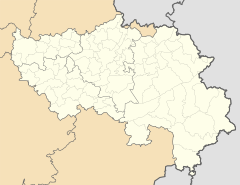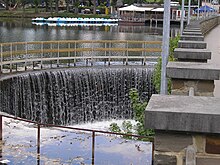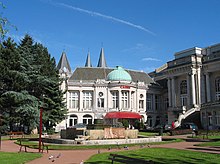Spa (city)
| spa | ||
|---|---|---|

|

|
|
|
|
||
| State : |
|
|
| Region : | Wallonia | |
| Province : | Liege | |
| District : | Verviers | |
| Coordinates : | 50 ° 29 ′ N , 5 ° 52 ′ E | |
| Area : | 39.85 km² | |
| Residents: | 10,229 (Jan. 1, 2019) | |
| Population density: | 257 inhabitants per km² | |
| Height: | 260 m | |
| Post Code: | 4900 | |
| Prefix: | 087 | |
| Mayor: | Sophie Delettre ( MR ) | |
Local government address : |
Administration Communale 44, rue de l'Hôtel de ville 4900 Spa |
|
| Website: | www.villedespa.be | |
Spa is a city in the Belgian province of Liege , in the Wallonia region . It is located in the Ardennes , 35 kilometers from the German border.
Was created in the name of the town of Spa English the generic term Spa as a synonym for "spa".
geography
With Eupen , Monschau and Malmedy, Spa is one of the cornerstones of the High Fens and is located in the Wayai valley. From the Lac de Warfaaz , the river runs underground through Spa. Spa and its immediate surroundings are at an altitude of between 240 m and 480 m .
history
The springs of Spa could have been known as early as Roman times under Pliny the Elder , or at least in the early Middle Ages at the time of Saint Remaclus (7th century), founder of the nearby abbeys of Stablo and Malmedy . This is not historically proven.
The origin of the name Spa is controversial. One theory leads the name back to a Germanic word for "spit, spit". In any case, it was used to designate a spring, and this name passed on to the village that was formed here from the 14th century.
In the Middle Ages, Spa belonged to the Margraviate of Franchimont (after the castle in neighboring Theux ) and received city rights in 1594.
The systematic architectural expansion into a spa took place in the 18th and 19th centuries. Emperor Joseph II visited Spa in 1781.
During the First World War , Spa was the headquarters of the German Supreme Army Command from March to November 1918 . In November, Storm Battalion No. 5 (Rohr) served there to protect them and that of the Emperor .
The Spa Conference took place from July 5 to 16, 1920 . It was the first conference after the First World War that German statesmen again took part in the form of Chancellor Constantin Fehrenbach and Foreign Minister Walter Simons . This concerned the question of the reparations that the German Reich was to pay to the victorious powers after the war was lost , as well as the disarmament of Germany.
Spa initially experienced a decline in the second half of the 20th century. The reconstruction into a modern holiday and wellness center is in progress, together with extensive restoration work on the dilapidated structure and the establishment of a new tourist infrastructure at the beginning of the 21st century.
Culture and sights
Medicinal springs
The Heilbad Spa owes its good reputation to its mineral water sources. This water, which was associated with important healing powers relatively early, appears in numerous places, both in the vicinity of the city and in its center. From the 18th century, Spa developed into a meeting place for crowned heads and illustrious personalities, so that at some point the place was nicknamed Café de l'Europe . There is also a café with this name on Place Royale today, but it was not that meeting place.
Distributed in and around Spa, the springs and spa houses that bear the name of Pouhons are accessible to visitors. Some of them are named after the personalities who visited them. A circular route allows you to visit the following sources:
- Pierre-le-Grand , named after Tsar Peter the Great , who visited Spa in 1717, with fountain hall from 1880 and park; the ferrous water flows from a fish-shaped tap that has become a symbol of the city's tourist advertising;
- a spring named after the Prince de Condé with a higher mineral content, but which was only discovered in the 19th century. The fin de siècle fountain hall made of glass and metal was built over in 1988 with a glass pyramid (architect Marcel Geenen ).
- Tonnelet , this source was already known in the 17th century; the name is derived from the small kegs in which the water used to be collected;
- Sauvenière et de Groesbeek , the oldest known spring in the city, linked by tourism advertising with the legend of the sandal imprint of Saint Remaclus. It has always been a source of healing for young married couples with an unfulfilled desire to have children;
- “Géronstère” with sulphurous water, which Peter the Great also drank, as well
- "Barisart", a spring that still flowed through the meadows in the 19th century.
A monumental fresco by the local painter Antoine Fontaine inside the fountain building des Pouhins Pierre-le-Grand, Le Livre d'Or , (1894) shows 95 personalities from three centuries who are anachronistic gathering in front of the historic thermal bath building and communicating with one another. The group is dominated by four marble sculptures depicting Pliny the Elder, Saint Remaclus - insofar as suggesting that they already knew the healing springs - the allegory of music and himself. The artist worked on this fresco for 12 years.
The wealthy spa guests, called bobelins , were still walking around 1900 in the city center, which has now been partially renovated and redesigned. In the Parc de Sept Heures , which opened to the public in 1758 , people met at around 7 p.m. under the monumental metal construction by architect William Hansen , the Leopold II Gallery (1878), which connects two pavilions. In the spa gardens, monuments commemorate historical events and prominent visitors, for example the armistice memorial for Major William Radcliffe , made an honorary citizen of the city of Spa in 1925, as well as the monuments to the composer Giacomo Meyerbeer , the Spa-born writer Jean d'Ardenne and Marshal Ferdinand Foch .
Today's spa guest takes the glass panoramic funicular from the Hotel Radisson Blu, newly built in 2006 , to the thermal baths built in the same year on the hill Colline d ' Annette et Lubin, directly above the city. The hill bears its name after two protagonists from one of the Contes Moraux by Jean-François Marmontel , who are said to have been modeled on two real people from the city of Spa.
The interior of the new thermal baths under a high glass dome, together with the outside area, forms an area of 800 m² with thermal water at 32 ° C; there are also saunas, solariums and Turkish baths as well as offers for various applications.
Buildings
The city's historic buildings are concentrated around Place Royale and the surrounding alleys opposite the spa gardens.
The old thermal bath building ( Bains ) on the Place Royale was built between 1862 and 1868 in the classical style under the Flemish architect Tieleman Franciscus Suys . The facade and the central triangular gable are decorated with sculptures, the foyer and the other halls are painted in neo-Renaissance style. The old thermal baths were closed in 2004. It is planned to renovate the building inside and outside and to give it a new use (luxury hotel and commercial space).
The Casino de Spa and the adjoining Kursaal from 1920 replace a building that burned down in 1917; this in turn (opened in 1908) - equipped with a ballroom and theater - was the successor to the Redoute founded in 1762 , for which the self-promotion of the city of Spa claims that it is the oldest casino in the world. American roulette , blackjack , poker and various slot machine games are played; Various events, festivals, seminars and exhibitions are also held in this building today.
The church of St. Remacle in the Rhenish neo-Romanesque style dates from 1885; a previous building is occupied. It has a balanced double-tower west facade, a massive crossing tower, north and south transepts and an apse with a circular arched gallery . The furnishings date from the 19th century, apart from a Renaissance statue of St. Remaclus (16th century) from the previous building.
The Waux-Hall , a second gaming room, was built in 1770 by the architect Jacques-Barthélemy Renoz in the Louis- Seize style.
Today's town hall, once the grand hotel of the spa guests, dates from 1762 (also Louis-seize, architect Barthélémy Digneffe , who also designed the first building of the casino).
Sports

Racetrack
In neighboring Francorchamps is the Spa-Francorchamps race track , which was laid out in the 1920s on an approximately 14 km long triangle of country roads between the villages of Francorchamps (hairpin La Source ), Blanchimont and Stavelot . The race track is located in the municipality of Stavelot; the racing museum is also located here.
This high-speed track with long straights was boycotted by Formula 1 in 1969 because it seemed too fast and too unsafe. In 1970, after modifications, the last Grand Prix for the time being took place on this variant. At the end of the 1970s, a version shortened to approx. 7 km was built, on which "Formula 1" has been racing again since 1983. Until the end of the 1990s, the main parts of the route were open to general traffic as part of the road connection from Francorchamps to Malmedy and Stavelot on race-free days.
golf
As early as 1893 there was a 9-hole golf course on the plateau above the Sauvenière source , which was destroyed in the First World War.
Today's 18-hole course, designed by Tom Simpson in the 1920s , is located in the middle of a park landscape with historic trees that are several centuries old. The Royal Golf Club des Fagnes claims to have one of the most beautiful golf courses in Europe. It is also open to green fee players and is frequented by numerous Dutch and German guests.
traffic
The city lies with a train station on the Verviers – Spa-Géronstère railway line . The route ends at the Géronstère stop, one station behind the train station. The disused route in the further course is now used in some sections as a hiking and cycling path ( RAVeL ). The euregioAIXpress runs from Spa to Aachen in Germany .
Spa is connected to the Belgian motorway network via the A 27 / E 42 motorway. The various districts can be reached via exits 7 to 10. Spa can also be reached via the A 26 / E 25 .
The buses and the funicular are operated by TEC .
The regional airport Spa-Sauvernière is popular with German skydivers because of the liberal Belgian laws .
Town twinning
Spa has twinned cities with the French cities of Cabourg in Normandy , Eguisheim in Alsace and La Garde in the Var department .
sons and daughters of the town
- Renier Roidkin (1684–1741), 18th century Walloon painter
- Frantz Jehin-Prume (1839–1899), violinist and composer
- Barthélémy Bruyère (1881–1950), racing car driver
- René Defossez (1905–1988), Belgian composer and conductor
- Jean-Pierre Talbot (born 1943), actor
Honorary citizen
- Michael Schumacher (* 1969), former German Formula 1 driver
literature
- Volkmar Eidloth: European spa towns and fashion spas of the 19th century. Theiss, Stuttgart 2012, ISBN 978-3-8062-2729-1 .
Web links
Individual evidence
- ↑ Spa: Sophie Delettre Succede à Joseph Houssa! (No longer available online.) In: Sudinfo.be. October 14, 2018, archived from the original on October 15, 2018 ; accessed on October 14, 2018 (French). Info: The archive link was inserted automatically and has not yet been checked. Please check the original and archive link according to the instructions and then remove this notice.
- ^ Irene Strenge: Spa in the First World War (1914-1918): military hospital and large headquarters. German occupation policy in Belgium. Königshausen & Neumann, Würzburg 2007, ISBN 978-3-8260-3693-4 . The book is based on a detailed contemporary account of the 'Secrétaire communal' of Spa. (Excerpt here )






